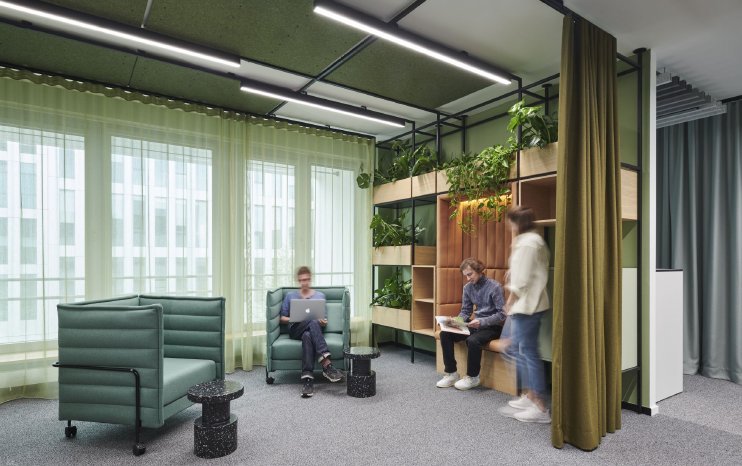We spend 90 percent of our time in buildings. We want to feel comfortable there and be protected from disturbing environmental factors. The design of interior spaces has a decisive influence on our health and productivity. The interior designers at blocher partners focused on low-emission design and the use of recyclable building materials. All existing office elements such as interior wall modules, doors, and furniture were assessed for reusability and reused wherever possible. New furniture was used primarily in common areas. Extensive landscaping of the offices ensures a healthy and pleasant working environment.
State-of-the-art technology further enhances the spatial experience: biodynamic luminaires are automatically controlled throughout the working day so that the light color and illuminance correspond as closely as possible to daylight. Sensors also monitor air quality. Acoustically effective ceiling sails and baffles help improve room acoustics.
Innovation and Sustainability in the Agile Office
blocher partners has developed a new working environment that is partly structured according to the principles of New Work and partly according to traditional principles. Offices with two-to-six workstations go hand-in-hand with communicative open spaces separated by curtains. Workstations are not assigned to individuals but are instead booked via a terminal (desk sharing). This has significantly reduced the number of workstations. In addition, common areas are located in the entrance areas of each floor.
While the classic office spaces are kept neutral in blue and gray, shades of green combined with orange niches and light oak furniture accentuate the common areas. The meeting rooms are clad in black slats for a sophisticated look.
Pioneering sustainable interior design
"With the Agile Office, we have created pioneering, high-quality working environments for ALLPLAN. The DGNB platinum certificate is confirmation and recognition that we have achieved the highest international standards in terms of sustainability. The health of our employees is just as important to us as climate protection and long-term profitability," says Dr. Detlef Schneider, CEO of ALLPLAN.
The DGNB is Europe's largest network for sustainable construction. The association's goal is to promote sustainability in the construction and real estate industry and to anchor it in the public consciousness. With the DGNB certification system, the DGNB has developed a planning and optimization tool for assessing sustainable buildings and districts, which helps to increase the actual sustainability of construction projects. The DGNB system does not evaluate individual measures, but rather the project as a whole.
About the DGNB
Founded in 2007, the DGNB is now Europe's largest network for sustainable building with over 2,500 member organizations. The aim of the association is to promote sustainability in the construction and real estate industry and to anchor it in the consciousness of the general public. With the DGNB certification system, the independent non-profit organization has developed a planning and optimization tool for evaluating sustainable buildings and districts that helps to increase real sustainability in construction projects. The DGNB system is based on a holistic understanding of sustainability that takes equal account of the environment, people and economic efficiency. Over 10,000 people in more than 60 countries have already been trained as experts in sustainable building via the DGNB Academy training and further education platform.
More information: www.dgnb.de



